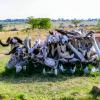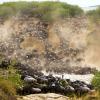Mount Everest's Dead, Frozen, and Left at the Summit Bodies
Mount Everest, the tallest peak on Earth, stands as a daunting challenge for climbers, and tragically, it has also become a resting place for many who attempted its ascent. The extreme conditions, high altitude, and unpredictable weather make it one of the most perilous places on the planet.
Everest bodies of climbers who have perished on Everest remain in various locations along its routes, including the summit. Due to the harsh environment and the logistical challenges of high-altitude recovery operations, many of these bodies have been left where they fell. Some have become landmarks, serving as eerie reminders of the mountain's unforgiving nature.
Efforts have been made to retrieve some bodies mt everest, particularly those in more accessible areas, either by fellow climbers or through organized recovery missions. However, the extreme altitude, treacherous terrain, and logistical difficulties make it impossible to recover all of them.
In recent years, there have been discussions within the climbing community and among mountaineering organizations about the ethics of leaving bodies at mount Everest. Some argue that leaving them preserves the mountain's history and serves as a cautionary reminder to future climbers about the risks involved. Others advocate for more concerted efforts to recover and respectfully inter the remains.
Regardless of the debates, the presence of these fallen climbers underscores the inherent dangers of attempting to conquer Everest and serves as a solemn testament to the human pursuit of adventure and exploration.
Why Bodies Are Left on Mount Everest
There are several reasons why bodies are often left on Mount Everest:
- Extreme Conditions: Mount Everest is one of the most inhospitable environments on Earth. The high altitude, extreme cold, and harsh weather make it extremely difficult to recover bodies everest once climbers have perished. The risks to the lives of potential rescuers are also significant.
- Logistical Challenges: Mount Everest is remote and located in a rugged, high-altitude terrain. Transporting equipment and personnel to such a location is logistically complex and expensive. Helicopters can only operate up to a certain altitude, and beyond that, everything must be carried by human porters.
- Safety Concerns: Recovering bodies from high altitudes on Everest is inherently dangerous. The risk of avalanches, crevasse falls, and altitude sickness is high. Rescue missions put the lives of rescuers at significant risk, and sometimes the risk outweighs the potential benefits of recovery.
- Climbing Priority: In many cases, climbers who come across bodies while attempting their ascent have their primary focus on reaching the summit or ensuring their own safety. They may not have the resources or capabilities to conduct a recovery operation.
- Preservation: The extreme cold and lack of moisture on Everest can act as a natural preservation mechanism, essentially mummifying the bodies. Some argue that leaving the bodies where they are preserves them in a way that burial or cremation at high altitude would not.
- Respect for the Deceased: Climbers who perish on Everest are often accorded a certain level of respect by the climbing community. Removing a body from the mountain can be seen as disturbing their final resting place and interfering with the natural order of things.
While leaving bodies on Everest may seem callous to some, it's important to recognize the practical challenges and ethical considerations involved in attempting recoveries at such extreme altitudes and in such hostile conditions.
Famous Deceased Climbers on Everest
Mount Everest has seen the loss of many climbers over the years, some of whom were well-known within the mountaineering community or achieved fame through their Everest attempts. Here are a few notable climbers who lost their lives on Everest:
-
George Mallory and Andrew Irvine
Perhaps the most famous of all, Mallory and Irvine disappeared during their summit attempt in 1924. Their disappearance sparked decades of speculation about whether they reached the summit before perishing. Mallory's body was found in 1999, but Irvine's remains have never been located.
-
Rob Hall
A New Zealand mountaineer and expedition leader, Hall was a central figure in the tragic events of the 1996 Everest disaster, which claimed the lives of eight climbers during a storm. Hall was leading a commercial expedition and perished while trying to help stranded clients. His story was depicted in Jon Krakauer's book "Into Thin Air" and the subsequent film adaptation.
-
Scott Fischer
An American mountaineer and guide, Fischer also perished in the 1996 Everest disaster. He was leading another commercial expedition and, like Hall, lost his life while trying to assist climbers caught in the storm.
-
David Sharp
A British climber, Sharp died in 2006 in a highly controversial incident. He was attempting the climb independently and encountered difficulties near the summit. Despite passing by him, several climbers did not offer assistance, leading to a debate about ethics and responsibility in high-altitude mountaineering.
-
Hannelore Schmatz
A German climber, Schmatz died in 1979 near the summit of Everest. She became the first woman to perish on Everest's summit slopes. Her body remained visible to subsequent climbers for many years before eventually disappearing beneath the snow.




